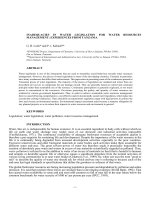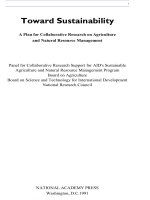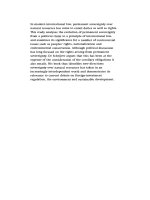SUSTAINABLE NATURAL RESOURCES MANAGEMENT potx
Bạn đang xem bản rút gọn của tài liệu. Xem và tải ngay bản đầy đủ của tài liệu tại đây (7.1 MB, 178 trang )
SUSTAINABLE NATURAL
RESOURCES MANAGEMENT
Edited by Abiud Kaswamila
Sustainable Natural Resources Management
Edited by Abiud Kaswamila
Published by InTech
Janeza Trdine 9, 51000 Rijeka, Croatia
Copyright © 2011 InTech
All chapters are Open Access distributed under the Creative Commons Attribution 3.0
license, which allows users to download, copy and build upon published articles even for
commercial purposes, as long as the author and publisher are properly credited, which
ensures maximum dissemination and a wider impact of our publications. After this work
has been published by InTech, authors have the right to republish it, in whole or part, in
any publication of which they are the author, and to make other personal use of the
work. Any republication, referencing or personal use of the work must explicitly identify
the original source.
As for readers, this license allows users to download, copy and build upon published
chapters even for commercial purposes, as long as the author and publisher are properly
credited, which ensures maximum dissemination and a wider impact of our publications.
Notice
Statements and opinions expressed in the chapters are these of the individual contributors
and not necessarily those of the editors or publisher. No responsibility is accepted for the
accuracy of information contained in the published chapters. The publisher assumes no
responsibility for any damage or injury to persons or property arising out of the use of any
materials, instructions, methods or ideas contained in the book.
Publishing Process Manager Gorana Scerbe
Technical Editor Teodora Smiljanic
Cover Designer InTech Design Team
Image Copyright WDG Photo, 2011. Used under license from Shutterstock.com
First published December, 2011
Printed in Croatia
A free online edition of this book is available at www.intechopen.com
Additional hard copies can be obtained from
Sustainable Natural Resources Management, Edited by Abiud Kaswamila
p. cm.
ISBN: 978-953-307-670-6
free online editions of InTech
Books and Journals can be found at
www.intechopen.com
Contents
Preface IX
Part 1 Application of Models, Remote Sensing and
GIS in Natural Resource Management 1
Chapter 1 Fuzzy Image Processing,
Analysis and Visualization Methods for
Hydro-Dams and Hydro-Sites Surveillance and Monitoring 3
Gordan Mihaela, Dancea Ovidiu, Cislariu Mihaela,
Stoian Ioan and Vlaicu Aurel
Chapter 2 Upstream Landscape Dynamics of
US National Parks with Implications for
Water Quality and Watershed Management 27
William B. Monahan and John E. Gross
Chapter 3 Sustainable Management of Large Scale
Irrigation Systems: A Decision Support Model
for Gediz Basin, Turkey 51
Murat Kilic and Suer Anac
Part 2 Climate Change Mitigation and Adaptation 83
Chapter 4 Sustainable Use of Natural Resources of
Dryland Regions in Controlling of
Environmental Degradation and Desertification 85
Peter F. Ffolliott
Part 3 Natural Resources Management and
Poverty Alleviation 103
Chapter 5 Sustainable Natural Resource Management,
a Global Challenge of This Century 105
Esmail Karamidehkordi
VI Contents
Chapter 6 Roles of Diverse Stakeholders in Natural Resources
Management and Their Relationships with
Regional Bodies in New South Wales, Australia 115
Brent C. Jacobs and Peter R. Brown
Chapter 7 An Analysis of the Contribution of Community Wildlife
Management Areas on Livelihood in Tanzania 139
Abiud Kaswamila
Chapter 8 Assessment of Livestock Loss Factors in
the Western Serengeti, Tanzania 155
J. W. Nyahongo and E. Røskaft
Preface
Archaeological evidence suggests that the earliest Neolithic resource users made their
decisions on resource use by selecting the best areas for different uses. Resource
management strategies have been influenced to varying extents by the nature of the
land ever since (Mango, 1996). Conscious land use planning, now worldwide
considered to be a panacea of resource use conflicts and a way of increasing
productivity, originated during the Greek empire when philosophers like Socrates,
Plato and Aristotle encouraged reasoning, logic, invention and scientific ways of
solving problems.
On the other hand, past and present efforts on land resources management seem to be
inadequate as land degradation, climate change, and demographic pressure continue
unabated and land productivity continues to decline at an alarming rate, which is
symptomatic of our failure to mitigate the problems. We now channel more than 40%
of terrestrial net primary productivity, which is sustenance of all animals and
decomposers, to our own needs (Vitousek et al., 1986). Forty-five percent is under
cropland and permanent pasture, 36% of Africa, 30% of North America, 35% of South
America, 47% of Europe, 25% of former Soviet Union (Woodroffe et al., 2005).
The current rate of land resources degradation worldwide is sending a shockwave
through mankind. Statistics show that soil erosion and other factors are leading to an
irreversible loss of land productivity on more than six million hectares of fertile land a
year - about 24% of the inhabited land (Lal, 1993). The values of individual continents
range from 12% in North America, 19% in Ocenia, 26% in Europe, 27% in Africa and
31% in Asia (Lal, 1993). Regardless of the methods used for the assessment, it is clear
that it is a worldwide problem requiring attention. For example, the Sub-Saharan
Africa imports about 10 million tons (60% of demand) of rice annually at a cost of
around US $ 6 billion, which is the largest continent’s import bill after petroleum
(Ngailo & Kaswamila, 2011). In other words, the need for natural resources
conservation is as great today as it ever was. Entering the 22
nd
Century, the challenges
to scientists, conservationists, politicians, planners, and decision-makers are to make
the world a safe place to live in, today and tomorrow, for the benefit of the present and
future generations. Our children and grandchildren should not ask us: why didn’t you
take action to safeguard our planet?
X Preface
This book is about finding the best way to manage challenges emanating from
accelerating natural resource use. The contributors in this book have vast expertise and
experience in natural resources management. All the chapters suggest that sustainable
natural resources management can only be achieved through use of system thinking to
help us think and learn collectively how to manage complexities and challenges. It
provides an integrated approach which finally creates an enabling environment for
stakeholders to adopt and benefit from; and adoption of resilience thinking as a
paradigm for systematic natural resource management planning process that offers
hope of transformational change in the management of socio-ecological systems. It is
also evident that technology use such as GIS and remote sensing and modelling have
great roles in natural resources management.
Abiud Kaswamila
Department of Geography and Environmental Studies
The University of Dodoma, Dodoma
Tanzania
Part 1
Application of Models, Remote Sensing and
GIS in Natural Resource Management
1
Fuzzy Image Processing, Analysis and
Visualization Methods for Hydro-Dams and
Hydro-Sites Surveillance and Monitoring
Gordan Mihaela
1
, Dancea Ovidiu
1
, Cislariu Mihaela
1
,
Stoian Ioan
2
and Vlaicu Aurel
1
1
Technical University of Cluj-Napoca,
2
S.C. IPA S.A. CIFATT Cluj,
Romania
1. Introduction
The continuous surveillance, monitoring and operational planning of hydro-dams and
hydro-sites is a very important issue, considering the impact of these critical structures on
the environment, society, economy and ecology. On one hand, the failure of hydro-dams can
dramatically affect the environment and humans; on the other hand, the operating policies
must take into account the impact of the water resource exploitation on the hydro-site
region and on the regions supplied by the reservoir.
The importance of periodic surveillance and monitoring through both objective
measurements and subjective observations is emphasized by existing international
standards, which provide the main surveillance and monitoring guidelines for hydro-dams
and hydro-sites (CSED, 1983; DSC, 2010). Among other issues, these guidelines clearly state
that the visual inspection of the hydro-dams and their surroundings is an important
component of the surveillance process, as it aids the decision making process based on
direct observations (CSED, 1983, pp. 21-28). Visual inspections complement the other type of
data acquired from sensors and transducers placed within the dam body and its
surroundings. It is a common practice in hydro-dam surveillance to store the visual
observations by human observers in the form of visual observations records. Typically these
records regard the state of the reservoir, banks and slopes, concrete structure and
downstream valley, and are backed-up by digital image archives of the inspected structures
(CSED, 1983; Bradlow et al., 2002).
In respect to the water resource exploitation policy related to the hydro-sites, it is important
to develop tools for water resource management evaluation and planning. However these
should not be fully automated decision systems, but rather decision support components, to
assist the human specialists in establishing the best operation policy. According to the EU
Water Framework Directive (2000/60/EC), the water management plan must take into
account the natural geographical and hydrological unit rather than the administrative or
political boundaries (European Parliament, 2000). This assumes a thorough analysis of the
Sustainable Natural Resources Management
4
associated complex and heterogeneous data, to perform both the analysis of the current
resource management policy and to predict the impact of some management policy on the
environment, economy and society. Such a complex task is best performed by a computer
decision support system, considering the amount and diversity of the required
data/information to be processed. However since the decision on the best water resource
management policy to be adopted is to be made by specialists, it is important to provide the
decision support system with a human-compliant interface, both for introducing the input
information and for displaying the assessment and prediction results in a meaningful and
intuitive form to the end-user (this includes, besides numerical data, linguistic and
qualitative assessments and, of course, a visual description of the results and
recommendations, wherever this is possible). While adopting some existing fuzzy reasoning
strategies for the evaluation of the water resource management policy, we mainly
emphasize here on our contribution in the enhancement of the results presentation form –
particularly on the visual presentation of the future effect of some particular policy, as a geo-
typically textured map of the region, using image processing methods to transpose the
numerical and qualitative assessment results into a suggestive visual representation.
Most of the solutions presented in this chapter were integrated in a hydro-dam and hydro-
site surveillance system, devoted to the monitoring of the Tarnita hydro-site on the Somes
River in Transilvania County, Romania. The details of the fuzzy image processing and
analysis tools proposed are presented in the remaining of this chapter.
2. Problem formulation
Prior to the introduction of the proposed fuzzy image processing and analysis methods
suitable to the visual examination of the concrete hydro-dams surface condition and to the
visual rendering of the water resource management policy assessment in a hydro-site
region, we consider necessary to give a description of the addressed problems. This should
allow the reader to understand and acknowledge the fact that image processing methods
may indeed play an important role in the assessment and evaluation of hydro-dams and
hydro-sites, although this type of strategy is not so commonly encountered in the field. The
following three subsections briefly point the roles of image processing and analysis
methods, the role of artificial intelligence approaches and finally present the structure of the
system we designed for hydro-dams/hydro-sites monitoring and surveillance, with an
emphasize on the role of visual surveillance. Some of the significant references in the
scientific literature related to the subject are also outlined.
2.1 The role of image processing and analysis methods in hydro-dams surveillance
In order to enhance the visual observations made by human experts, computer vision
techniques may be employed. The approach is to acquire images and then, by the means of
specific image processing algorithms, enhance and analyse them. Also, the periodical
recording of these images into a database could prove very useful when monitoring the
overall condition of the dam walls during time.
Less interest was oriented on incorporating image processing and analysis algorithms to
automatically detect, diagnose and predict the behaviour of the dam and the possible faults
Fuzzy Image Processing, Analysis and
Visualization Methods for Hydro-Dams and Hydro-Sites Surveillance and Monitoring
5
affecting the structure of the dam. The main interest in processing was to create a 3-D dam
map, to be further investigated by the human operator, and even in this step, human
intervention is often required. Taking into account the wide variety of computer vision
algorithms currently available, is fair to consider that the automation of the visual inspection
process of the dam, aiming to detect, diagnose and predict possible faults, can be further
increased. Some of the methods presented in this chapter provide solutions to perform
specific image processing and analysis tasks in the particular case of infrared and visible
images of dam walls.
Bimodal analysis of optical and infrared images is a problem still needed to be tackled with.
Few such applications have been reported, mainly in the fields of surveillance, people
counting and tracking, robust skin detection (face detection), forest fires detection, or land
mines detection (Ollero et al., 1998; O’Conaire et. al., 2006). However, for the diagnosis of
dams such works are scarce, although infrared imaging is used extensively in assessing
temperature loss, or poor isolations in buildings.
Thermal images can provide information about the scene being scanned which is not
available from a visual image. Although much work has been performed for finding various
image segmentation techniques in both imaging modalities, little efforts have been made for
integration of complementary information extracted from the two imaging modalities.
2.2 The role of artificial intelligence techniques in hydro-sites operation monitoring
The significant development of the information systems puts nowadays its fingerprint on
the hydro-sites surveillance and monitoring as well, with a strong emphasize on the design
and implementation of intelligent systems to assist the specialists in the above mentioned
areas. The artificial intelligence methods play a significant role in the development of
systems devoted to dam surveillance and dam monitoring, especially in the form of decision
support components and knowledge-based expert systems; among these methods, the well-
known fuzzy theory and machine learning solutions (especially neural networks) are
commonly employed. Some examples of such artificial intelligence based solutions for
hydro-dams and hydro-sites surveillance, monitoring and assessments are briefly
mentioned herein. Knowledge-based systems have been employed to assist the diagnosis of
seepage from different types of hydro-dams (Asgian et al., 1988; Sieh et al., 1998). Neural
networks are also employed in the investigation of seepage under concrete dams founded
on rock (Ohnishi & Soliman, 1995) or in the estimation of the dam permeability (Najjar et al.,
1996). The joint use of fuzzy mathematics and neural networks is also reported by (Wen et
al., 2004), in the development of a bionics model of dam safety monitoring composed of
integration control, inference engine, database, model base, graphics base, and input/output
modules. Fuzzy logic and artificial neural networks were employed in the inference models
building stage, needed to analyze and evaluate the run characteristics of dams.
2.3 Overview of the integrated hydro-site surveillance and monitoring system
Artificial intelligence techniques (including fuzzy logic, fuzzy knowledge based systems,
neural networks and other supervised classifiers) have been extensively employed recently
in hydro-dam and hydro-sites surveillance applications, as diagnostic tools and policy
Sustainable Natural Resources Management
6
recommendation tools. However, most existing solutions use measurements acquired from
different sensors, and very few of them integrate visual observations obtained from some
image analysis modules applied on digital images acquired during hydro-dams and hydro-
sites monitoring. In this respect, we describe here a set of image analysis tools developed
specifically for the concrete hydro-dams surveillance, which were implemented in the form
of an integrated computer vision-based hydro-dam analysis system, capable of providing
quantitative, qualitative and linguistic assessments of the concrete surface. The presented
visual inspections and expert system components are part of a large hydro-dam and hydro-
site surveillance system devoted to the monitoring of the Tarnita hydro-site on the Somes
River in Transilvania County, Romania; its block diagram is illustrated in Fig. 1.
Fig. 1. The integrated system for dam safety decision support, using computer vision
techniques and integrating the result of image analysis with the results of other data
analysis modules
The automatic acquisition equipments collect multi-sensorial data from the sensors placed
in the dam body. These equipments are: automatic acquisition station, capacitive sensor tele-
pendulum, optical tele-pendulum, tele-limnimeter, laser telemeter, infrared and visible
spectra cameras. All these data are stored into a relational multimodal database. The data
fusion algorithms are used to extract relevant information regarding water infiltrations in
the dam body, based on infrared and visible spectrum image fusion. Other image processing
algorithms are applied to dam wall surface roughness examination, which is also likely to be
caused by systematic water infiltrations. The dam models are used for dam behavior
prediction and utilize the information stored in the database. The expert system use the
human expert knowledge in specific domains and metadata resulted upon their own
inference. The decision support system links the user with modeling components, image
analysis and fusion modules, expert systems, and the database. Its role is to provide
synthetic data in graphical, numerical and linguistic format, which would help the dam
surveillance personnel in taking the right decisions regarding interventional measures that
will prevent dam degradation and will ensure its functioning in good conditions. Another
useful component that may be integrated in the system from Fig. 1 is the one devoted to
water resource management policy evaluation and prediction in the hydro-site and the
surrounding areas. Most commonly, such components are built using fuzzy rule base
systems/fuzzy logic systems, as this mathematical framework is very suitable to handle
both exact and approximate (qualitative or linguistic) knowledge, and this mixture of
Fuzzy Image Processing, Analysis and
Visualization Methods for Hydro-Dams and Hydro-Sites Surveillance and Monitoring
7
information representation is often encountered in management evaluation systems. Our
contribution in terms of a visually enhanced representation of the water resource
management policy assessment results is also presented in the end of this chapter.
3. Downstream concrete surface evaluation of hydro-dams by image analysis
Visual inspection is a key element in dam monitoring process, allowing decisions to be
made about dam behavior, based on direct observations. Visual inspections complement the
data analysis process concerning different sensors and transducers placed within the dam
body and it’s surroundings, and the observations are filled in a standardized form
describing the inspections results about: reservoir, banks and slopes, concrete structure,
downstream valley. These records hold, for every feature observed, the procedures utilized
during inspection as well as significant images illustrating the observations. Hence, once
digital images of the inspected structure are available, a series of aspects are suitable for
image analysis: detection and quantification of calcite deposits, detection of areas with
humidity, evaluation of concrete surface of the wall in order to reveal structure faults or
cracks, and so on.
It is a known fact that most cracks in dam walls have calcite exuding from them, indicating
that moisture traversed the cracks (Abare, 2006). As water seeps through cracks, it leaves
calcite deposits at the surface adjacent to the cracks. If the area between concrete layer is
porous, the movement of water through them would accelerate the leaching action. Seepage
samples may be collected, analyzed and compared to reservoir water to help determine
whether soluble minerals pose a structural safety problem (Craft et al., 2007). Seepage could
be estimated by estimating the volume of water required to precipitate the measured
volumes of calcite in the unsaturated zone (Marshall et al., 2003). Besides these techniques,
we will show that computer vision can also help detect and assess the calcite deposits and
humidity of the concrete dam walls.
The deterioration of the concrete walls may also be an important concern as it may indicate
the degradation of the downstream side, and to give an estimate of this type of degradation
we proposed a solution to examine the surface roughness (Gordan et al., 2008). Besides an
accurate identification of such deteriorations, we show that computer vision techniques help
in providing a quantitative and qualitative description of the extent of the deterioration. It is
important to note that all the results of the proposed computer vision techniques can easily
be transcribed to the visual observation record and offer the advantage of an intuitive and
natural presentation to the end user.
In terms of downstream concrete surface evaluation of dams, we propose the following:
1. A modified fuzzy c-means segmentation method (semi-supervised through the use of
support vector regression) for the detection, localization and quantification of calcite
areas in the plots of the downstream concrete surface of a hydro-dam. The difficulty of
this image segmentation problem comes from the large variability of calcite deposits
appearance, uneven distribution of data, variations of the concrete appearance
depending on the acquisition conditions and devices. The proposed solution
outperforms the classical segmentation algorithms in terms of accuracy (96% as
compared to 91% with the classical fuzzy c-means).
Sustainable Natural Resources Management
8
2. Furthermore, since less severe infiltrations may only be visible in the infrared spectrum,
we also propose an integration of infrared image analysis with the visible image
analysis, using a late decision fusion to integrate the results of the two image analysis
modules. The fusion is thought to take into account the spatial and temporal correlation
of the two types of images of the same hydro-dam downstream surface. This approach
should yield more reliable results in terms of infiltration assessment.
These algorithms and techniques are described in detail in the following sub-sections. The
images to be processed are drawn from the multimodal database, which holds digital
images of concrete dam walls. Such an image is illustrated in Fig. 2. These are cropped to
elementary units, called sub-plots. Each sub-plot image is identified by information that
allows later identification and association with the real scene (the identification data is:
horizontal, vertical and plot number). Thus, it is easier to extract images from the same sub-
plot taken at different dates or in different modalities (e.g. visible or infrared spectrum).
Fig. 2. Image sample at the input of the visual inspection module
3.1 Infiltration assessment by the analysis of calcite deposits using fuzzy
segmentation
Calcite patches are good indicators of significant and time persistent water infiltrations; they
are most likely to occur as being transported by the water infiltrations from concrete in the
case of a repetitive water infiltration in a certain area of the dam. Therefore the problem of
identifying the calcite formations on the concrete wall through an algorithm able to provide
maximum accuracy despite the variability of appearance of calcite deposits, the variable
lighting conditions on the portion of the wall, without knowing in advance if calcite is or is
not present in the current image, or in what amount, must be tackled. These aspects make
the calcite identification and assessment a rather difficult image analysis problem: the
Fuzzy Image Processing, Analysis and
Visualization Methods for Hydro-Dams and Hydro-Sites Surveillance and Monitoring
9
significant variability of the calcite appearance makes almost impossible the derivation of a
calcite appearance model to be used in the identification; model-free approaches seem more
suitable, trying to identify natural pixels clusters, followed by an interpretation of the
clustering results to identify if any represents calcite or not.
A rather powerful approach to non-supervised image segmentation by pixel clustering is
the fuzzy c-means algorithm (FCM) (Dunn, 1973; Bezdek, 1981). Many variations of the FCM
algorithm were successfully applied in image segmentation. Actually, various forms of
fuzzy clustering have been employed to different image segmentation tasks. In (Chamorro et
al., 2003), the segmentation of color images is achieved by a nested hierarchy of fuzzy
partitions, based on a measure of color similarity. Starting from an initial fuzzy
segmentation, a hierarchical approach, based on a similarity relation between regions, is
employed to obtain a nested hierarchy of regions at different precision levels. Type 2 fuzzy
sets are employed in (Clairet et al., 2006), for color images segmentation, to allow a better
modeling of the uncertainty. A modified fuzzy c-means segmentation scheme with spatial
constraints is introduced in (Hafiane et al., 2005), in the form of a two step segmentation
method. Another fuzzy clustering method, with no constraints on the number of clusters,
aiming to segment an image in homogeneous regions, is presented in (Das et al., 2006).
The solution that we proposed for the segmentation of the calcite deposits on the concrete
hydro-dam walls images is more application-targeted (and it worth noting that it may be
also generalized to other application-specific segmentation tasks, as it provides a framework
to incorporate a-priori knowledge in the fuzzy c-means cost function). Details on this
approach may also be found in (Dancea et al., 2010). The calcite identification on the concrete
dam wall can be treated as a pixel classification problem. As there is no prior knowledge
regarding the shape of the calcite deposits, the spatial constraints are not really helpful in
the segmentation; the colors of the pixels are the only relevant features to consider. An
important fact to consider however is the amount of the calcite deposits on each dam wall
image, which is significantly smaller than the entire wall region. If we build a data set to be
clustered comprising all the pixels in the currently analyzed image, classified into calcite
and non-calcite samples, this set will be highly unbalanced among the classes of interest,
and this is an unfavorable situation in a classification task, being prone to more errors in the
poor represented class. This situation can be partially overcame by defining the
classification data as the set of distinct colors in the concrete dam wall image, each color
being included only once. From the several possible color spaces, we prefer the natural Red
Green Blue (RGB) representation, as it is just as suitable as others for Euclidian distance
based classifiers; thus each sample (corresponding to a color from the image) is represented
by a vector
T
RGBx
. The image to be segmented is considered to be a sub-plot
image of a dam wall, as shown in Fig. 2. Therefore the current data set is formed by the
colors in this sub-plot color image,
X i 1,2, ,N ,
i
CC
x where N
C
denotes the number
of distinct colors in the current image. Our goal is to classify/cluster the data in X
C
in one of
two possible classes of interest: calcite deposit – denoted by
C
C , and not calcite – denoted
here by
C
c
. Although this is actually nothing else but a binary classification problem,
trying to solve it by an unsupervised fuzzy c-means clustering of the data in only two
classes will risk to be unable to group all the colors corresponding to the class “anything else
Sustainable Natural Resources Management
10
but calcite”, since their variance is too large. Therefore a larger number of classes than two
only will be needed in the initial clustering, one per dominant color. An examination of the
sub-plots shows that generally two dominant colors are present in the non-calcite sub-plot
areas: a grayish like color corresponding to the concrete and a brown-black color
corresponding to organic deposits. Thus a 3-class clustering should be performed, with two
classes for the
C
c
dataset and one the calcite,
C
C .
The fuzzy c-means algorithm (Bezdek, 1981) is a very efficient clustering procedure when
the number of clusters is known a-priori, aiming to find natural fuzzy groupings of the data
according to their similarity in respect to a selected distance metric. In the end of an iterative
objective function minimization process, the optimal class centers and membership degrees
of the data to be clustered are found, with the optimality defined as the minimization of the
classification uncertainty among the data in the classes. However a good clustering result is
only achieved if the amount of data in each cluster is relatively balanced; otherwise the
expected fuzzy centroid of the class with fewest data can be rather different than the real
centroid of the class. This is mainly due to the fact that although the distance between the
data and the resulting class center is large (leading to a large cost in the objective function),
if the number of these terms is negligible in comparison to the size of the data set, it will
contribute insignificantly to the total cost. While we already tried to avoid this case by
taking all the colors in the sub-plot only once, this caution might still not be enough to
guarantee a balanced data set. Therefore, furthermore, we propose to apply a modified
objective function in the fuzzy c-means clustering, which assigns a higher penalty to the
misclassification of the expected calcite pixels colors, that is, of the lighter colors in the data
set X
C
. We should mention here that, although the number of pixels colors corresponding
to the organic deposits (brown-black, that means – dark-most) is also much smaller than of
the grayish pixels, we are not concerned about their misclassification here, as in the worse
case, the color of a brown-dark pixel is closer to a grayish pixel than to a calcite one, and
then the misclassified data for the organic deposits can never appear in the calcite class
C
C .
Let us denote by C – the number of classes to which the N
C
samples x from the set X
C
are to
be assigned in some membership degree; in our case, C=3. The membership degrees of the
data to the classes is stored in a matrix
UC N
C
, where the u
ji
element, j=1, ,C and
i=1, ,N
C
, represents the membership degree of the vector
i
x to the class j. Each line in U is
the discrete representation of the fuzzy set corresponding to a data class. The C fuzzy sets
are constrained to form a fuzzy partition of the data set X
C
. Starting from any initial fuzzy
partition of the data set to be fuzzy classified X
C
, the algorithm aims to optimize the
partition in the sense of minimizing the uncertainty regarding the membership of every data
x
i
, i=1,…,N
C
, to each of the classes. In the proposed weighted fuzzy c-means algorithm, we
introduce a set of class-specific scalar positive weights w
j
, j=1,…,C, to assign different
relative importance to the distances of the data in X
C
to each of the classes centers. With
these weights, we build a fuzzy c-means weighted objective function in the form:
N
C
C
m2
JU,V uwd,
w,m
j
i
j
i
j
i1j1
xv (1)
Fuzzy Image Processing, Analysis and
Visualization Methods for Hydro-Dams and Hydro-Sites Surveillance and Monitoring
11
whose minimization is done iteratively, as in the standard fuzzy c-means algorithm, using
the following equations for the computation of the fuzzy class centers v
j
and for the fuzzy
membership degrees u
ji
:
N
C
u
j
ii
i1
;
j
N
C
u
j
i
i1
x
v
1
1
2
m1
wd ,
C
jij
u
ji
2
l1
wd ,
i
ll
xv
xv
(2)
In the expressions above, V is the set of the class centers, V={v
1
, ,v
C
},
3
v
j
; m is a
parameter controlling the shape of the resulting clusters (typically m=2);
d(·,·) is a distance
norm in the RGB space between any two vectors. A common choice for d, used in our
approach as well, is the Euclidian distance. The iterative process ends when the change in
either U or V is under a certain tolerance (error) (in theory, arbitrarily small).
The three weights w
1
, w
2
and w
3
are estimated roughly using the shape of the histogram of
the brightness component of the segmented image; the shape descriptor which proves
useful for our case is the skew of the histogram, as it provides a numerical measure of the
distribution of the samples to the left and right of their mean. Using solely the brightness
and not the color is sufficient for our goal, as our concern is to be able to “differentiate” the
light-most class (which accounts for calcite as explained above) from the other two classes.
Therefore we give default fixed weights to the non-calcite classes and tune just the calcite
class weight as indicated by the histogram’s skew. Considering an N sample set formed by
the brightness values of the pixels in the currently analyzed sub-plot,
y ,y , ,y
12 N
, the
sample’s skew γ can be estimated as the ratio between the third central moment of the
sample and the cube of the sample’s standard deviation:
N
3
1
yy
i
N
μ
1
N
3
i1
γ
,
yy
.
i
33
N
i1
N
2
22
1
μ
2
yy
i
N
i1
(3)
For a uni-modal histogram having the gray levels are evenly distributed around the mode, the
skew is close to zero. If more darker pixels than brighter pixels are present in the examined
image, the skew γ will be negative. On the opposite, if the brighter pixels are dominant and
outnumber the darker ones, γ will be positive. Based on these considerations, we can perform
the following adjustment of the calcite class weight depending on the skew γ (assuming the
other two classes have fixed weights). If γ is positive (i.e., the number of light pixels accounted
for calcite is large enough), there is no need to enhance the importance of the calcite class in
respect to the other two, and we can set the calcite weight equal to the other classes. If γ is
negative or near zero, it indicates the areas of calcite are rather small as compared to the
examined surface, so the calcite class weight should be increased. Intuitively, the more
negative γ is, the larger the weight assigned to the calcite class should be.
Sustainable Natural Resources Management
12
Note that although there is no a-priori association of the class index j, j=1,2 or 3, and the
brightness of the colors in the class, we always know that the fuzzy class with light most
colors is the fuzzy class whose center is the lightest, and this class will be considered to
correspond to the calcite (if any):
CCkar
g
max 0.299 0.587 0.114 .
j
C
k
j1,2,3
v
(4)
To be able to effectively employ the above considerations into our algorithm, a numerical
mapping between the range of values γ and the range of weights of the light-most, i.e.
calcite pixels class, must be obtained. Denoting our target weight by w
k
, with k given by Eq.
(4), we search for the mapping w
k
(γ) that best fits a set of training data, obtained by
manually tuning the value w
k
on a set of statistically significant dam wall images (with
enough variability in appearance, to cover as many practical cases as possible). A set of 15
images of several sub-plots, with different aspect, under different lighting conditions and
different amounts of calcite (from none to very severe) have been selected and manually
analyzed to optimize the calcite class’ weight for an accurate calcite identification. The pairs
formed by the skew values and the best manually selected weight values w
k
have been
collected, and an interpolation procedure based on support vector regression (SVR) has been
applied on this training set to completely define in an automatic fashion the computation of
the weight w
k
. We assumed the other two classes’ weights “fixed” to 1.
The reason for using SVR in the interpolation step is its proven good performance when
only a relatively sparse set of data points is available. Based on Vapnik and Chervonenkis’s
statistical learning theory (Vapnik, 1998), support vector learning principle allows handling
successfully difficult cases, with better precision and recall than other learning methods.
This is mainly due to the structural risk minimization principle implemented by SVMs.
SVMs were initially “built” for classification and later extended to the regression issue –
SVR – by introducing a loss function (Scholkoph
et al., 1998; Platt, 2000). Starting from an
input data set, represented by a vector x, the SVM learns the functional dependency
between input and output, represented in the form of a scalar-valued function f(x). The
expression of the regression function provided as a result of learning by an SVM is:
*
L
f( ) ααK( , ),
ii i
i1
xxx (5)
where L denotes the total number of training data,
i
and *
i
are their associated Lagrange
multipliers, and the function K(x,x
i
) represents a kernel function used for mapping the input
data in a higher dimensional input space. In our experiments, a polynomial kernel of degree
7 was considered. According to the observed skew values in our images, its range was
limited to [-2;2]. The range of values for the weights w
k
is chosen to be [1;10]. The resulting
mapping w
k
(γ), after applying SVR on the training set is represented in Fig. 3.
Experiments were run on a set of 15 large, high resolution images, from which we chose 60
manually segmented sub-plots (as illustrated in Fig.2). The performance of the proposed
segmentation method was assessed on the test set of 60 sub-plots, using a previously
manually drawn ground truth (on which the calcite regions were manually marked). The
Fuzzy Image Processing, Analysis and
Visualization Methods for Hydro-Dams and Hydro-Sites Surveillance and Monitoring
13
difference between the ground truth segmentation and the segmentation result of our
algorithm allows us to assess the segmentation error, the false positives and the false
negatives for the calcite class. The segmentation error for the calcite class achieved with our
method, expressed as the average percentage of misclassified pixels in the test set for the
total 60 sub-plots, is 4.19%, whereas for the standard fuzzy c-means algorithm is 9.64%(more
than double). Some segmentation results are illustrated in Fig. 4.
Fig. 3. Skew to class weight mapping
(a) (b) (c)
Fig. 4. Example of the calcite segmentation for a sub-plot: (a) the original (not segmented)
sub-plot image; (b) the fuzzy c-means segmentation result; (c) the proposed weighted fuzzy
c-means segmentation result.
Despite the good performance of this segmentation procedure in the localization of calcite,
one must take into account that less severe infiltrations may not produce significant calcite
deposits yet, and may only be visible in the infrared spectrum. Therefore the integration of
infrared image analysis results with the visible image analysis results, using a late decision
fusion, can bring more valuable information in the infiltration assessment. The fusion is
thought to take into account the spatial and temporal correlation of the two types of images
of the same hydro-dam downstream surface. This approach is presented in the following
sub-section.









